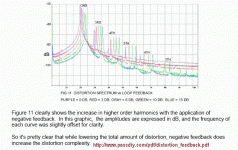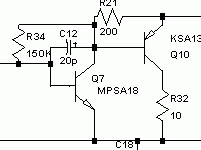Hello
Nelson Pass wrote an interesting article about thd spectrum and negative feedback.
http://www.passdiy.com/pdf/distortion_feedback.pdf
Any opinions about that subject ?
Myself I've found, for all my amps, that keeping the open loop gain under
arround 65 db and using a global negative feedback lower than 35 db,
do sound better.
Bye
Gaetan
Nelson Pass wrote an interesting article about thd spectrum and negative feedback.
http://www.passdiy.com/pdf/distortion_feedback.pdf
Any opinions about that subject ?
Myself I've found, for all my amps, that keeping the open loop gain under
arround 65 db and using a global negative feedback lower than 35 db,
do sound better.
Bye
Gaetan
Attachments
Last edited:
we've beat the subject to death in the Cordell negative feedback thread
Baxandall (and others before and after) have done the negative feedback "harmonic growth" math - among the the conclusions:
that it is worst at ~ 10-15 dB feedback
it doesn't depend on wether the feedback is "global" or local" - it can be seen with degeneration too
just use lots of negative feedback once youv'e started using any at all and above ~40 dB of feedback all harmonic distortion orders are reduced, and they assume the decreasing level as order increases pattern so many claim is important
higher order compensation, fast output devices allow up to 60 dB loop gain in audio power amps at 20 KHz so all conventional "audio" signals can benefit from high feedback factor distortion reduction
not directly related but Otala's TIM concerns can be addressed in input, VAS, compensation design and Is Not made worse by high negative feedback factor - or even a sloping feedback factor in the audio band - the "flat open loop bandwidth over the audio range" perscription is simply wrong on TIM grounds
(although Bode's maximal feedback design does use flat feedback factor over the working band to boost the bandwidth benefiting from high feedback factor by an octave)
I think Cherry did the best feedback "distortion growth" math job in:
Cherry, “Estimates of Nonlinear Distortion in Feedback Amplifiers” JAES V48#4 2000
a bad use of high feedback is to try to "fix" a bad amplifier design with static or dynamic underbiased output devices which show deadbands with expected loads and V,I slewing requirements
build linear stages with generous bias that can handle the required real world loads, signals with only smooth nonlinearities and there is no indication that high negative feedback does anything except improve the amp's linearity at the usual and quite controllable cost in frequency compensation for stability
Baxandall (and others before and after) have done the negative feedback "harmonic growth" math - among the the conclusions:
that it is worst at ~ 10-15 dB feedback
it doesn't depend on wether the feedback is "global" or local" - it can be seen with degeneration too
just use lots of negative feedback once youv'e started using any at all and above ~40 dB of feedback all harmonic distortion orders are reduced, and they assume the decreasing level as order increases pattern so many claim is important
higher order compensation, fast output devices allow up to 60 dB loop gain in audio power amps at 20 KHz so all conventional "audio" signals can benefit from high feedback factor distortion reduction
not directly related but Otala's TIM concerns can be addressed in input, VAS, compensation design and Is Not made worse by high negative feedback factor - or even a sloping feedback factor in the audio band - the "flat open loop bandwidth over the audio range" perscription is simply wrong on TIM grounds
(although Bode's maximal feedback design does use flat feedback factor over the working band to boost the bandwidth benefiting from high feedback factor by an octave)
I think Cherry did the best feedback "distortion growth" math job in:
Cherry, “Estimates of Nonlinear Distortion in Feedback Amplifiers” JAES V48#4 2000
a bad use of high feedback is to try to "fix" a bad amplifier design with static or dynamic underbiased output devices which show deadbands with expected loads and V,I slewing requirements
build linear stages with generous bias that can handle the required real world loads, signals with only smooth nonlinearities and there is no indication that high negative feedback does anything except improve the amp's linearity at the usual and quite controllable cost in frequency compensation for stability
Last edited:
Member
Joined 2009
Paid Member
Sometimes the simple maths is too simple. For example, degenerative feedback can be quite different in it's impact compared with global - it generally has much less phase shift and rarely requires stability compensation. We know from our own experience that compensation can have a profound effect on sonics. Degenerative feedback is very accurate - it uses the device itself as the error amplifier. To me, it's intuitively kinder on the music than any kind of loop feedback.
I'm not so sure about CFP yet, it has a reputation for good sound and the feedback loop is very tight between the two devices - not tight enough to avoid the danger of instability though.
Feedback has many other consequences not just the mathematical impact on harmonics. It affects clipping behaviour, PSRR, and provides a path into the amplifier for any rf pickup or speaker driver back emf on the output. It changes the effective output impedance.
Good or bad I reckon it's interesting to have the option of using it or not using it. Not using gnf with a Class AB amplifier is not easy. It's difficult to control distortion at the output and its difficult to design a VAS with a gain of order 10dB (it's easier to make a gain of 0.98 or > 10dB). You have to take care with PSRR and frequency response because there's no gnf to fix all the warts.
I'm not so sure about CFP yet, it has a reputation for good sound and the feedback loop is very tight between the two devices - not tight enough to avoid the danger of instability though.
Feedback has many other consequences not just the mathematical impact on harmonics. It affects clipping behaviour, PSRR, and provides a path into the amplifier for any rf pickup or speaker driver back emf on the output. It changes the effective output impedance.
Good or bad I reckon it's interesting to have the option of using it or not using it. Not using gnf with a Class AB amplifier is not easy. It's difficult to control distortion at the output and its difficult to design a VAS with a gain of order 10dB (it's easier to make a gain of 0.98 or > 10dB). You have to take care with PSRR and frequency response because there's no gnf to fix all the warts.
Hello
To have more gain you need multiple stages in the amp and as wrote in the Nelson Pass's document, the more stage you have the more IM thd you will have with a complex signal like the musics.
To have gain and drive I use this buffered Vas and I ad a local feedback, I keep the number of stages to minimum in my amps.
A sine wave in a simulations or on a resistive load are easy for an amp but all things change on a real speakers load with a complex signal like musics.
Bye
Gaetan
To have more gain you need multiple stages in the amp and as wrote in the Nelson Pass's document, the more stage you have the more IM thd you will have with a complex signal like the musics.
To have gain and drive I use this buffered Vas and I ad a local feedback, I keep the number of stages to minimum in my amps.
A sine wave in a simulations or on a resistive load are easy for an amp but all things change on a real speakers load with a complex signal like musics.
Bye
Gaetan
Attachments
Last edited:
- Status
- This old topic is closed. If you want to reopen this topic, contact a moderator using the "Report Post" button.

